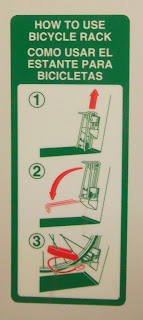 |
| At Santa Rosa North Station |
While not herself a cyclist, this other rider, Anet Dunne, observed a male passenger have difficulty securing his bike and that of his child from hanging racks aboard the SMART Train. Her write-up gave me concern, so I resolved to pay close attention when we took our own SMART Train ride.
At the Santa Rosa North station on Saturday, July 8, Jonathan and I boarded the southbound train during its 8 a.m. run. We did not bring our bikes for this trip, but another cyclist allowed us to observe him while he secured his bicycle.
Bike storage seems easy to access
 |
Aboard Dunne’s train, the male cyclist had to take down his bicycle and re-hang it “handlebars-down,” apparently under direction by a security guard.
Aboard our train, I also saw two bicycles hang side-by-side from their hooks within two-bike compartments. Both of the bicycles were “handlebars up,” side-by-side — so I don’t know why the male passenger aboard Dunne’s train was not able to hang his son’s bicycle next to his own in a two-bike compartment.
The rear tires of each bicycle are secured by lanyards that hold them immobile in fold-out cleats mounted to the wall. The rider we observed did not have trouble accessing the lanyard and clipping it through the wheel of his bicycle.
Aboard the SMART Train, another option exists for commuting with a bicycle. A row of fold-down seats have sets of lanyards mounted on the seat back-rests. These lanyards clip through the frame of an upright bicycle, two lanyards per bicycle. This part of the train is also intended to accommodate passengers who travel in wheelchairs.
Clipper Card accepted aboard SMART Train
 |
| Next to Clipper Card reload machine |
Clipper bills itself as the “all-in-one transit card for the Bay Area,” and SMART Train’s acceptance of the Clipper Card is a major strength. Instead of juggling fares or passes for multiple transit systems, we can pay for everything with one card. (This being a preview ride, of course, we did not tag on and off with Clipper in order to ride the SMART Train.)
Comfortable seats and amenities
The train itself had rows of two seats facing forward or backward (depending on direction of travel). These seats had fold-down trays available from the seat-back of the seats in front of them.
There were also arrangements of seats to accommodate groups of four: two sets of seats, facing each other, with a table between them.
Within the cars, we could access free on-board WiFi, but it seemed as though a router was located within only one of two cars; Jonathan observed “great” signal in one car, but “almost no signal” in the other.
The train had a bathroom and a concession stand that sold coffee, beer, wine, bottled water, and snacks.
Water bottle refill, please
Which leads me to one major improvement I’d like to see adopted aboard the SMART Train or (if more feasible) in its stations. In addition to wasteful single-serving bottled water, please offer refill stations and encourage reuseable bottles.
When commodified and sold, bottled water costs 2,000 times more than water from the tap (that statistic comes from Annie Leonard narrating The Story of Stuff’s “Story of Bottled Water”).
These bottles too-often end up a blight on the landscape and take “forever” to break down. (One empty bottle ended up a blight on the SMART Train itself — whoever used it, instead of throwing it away, left it braced in a fold-down seat.)
An overview of station amenities on the SMART Train website make no mention of drinking fountains or water-bottle refill stations. The key areas of focus when listing station amenities are the stations’ accessibility, transit connections, bicycle facilities, and parking.
Among SMART promotions, I’d love to see reusable water bottles with the SMART Train logo. Talk about “SMART Swag!”
Considering the appeal of SMART-Train use among people who want to protect the environment, it makes sense to facilitate the environmental responsibility of not using disposable water bottles.
No comments:
Post a Comment